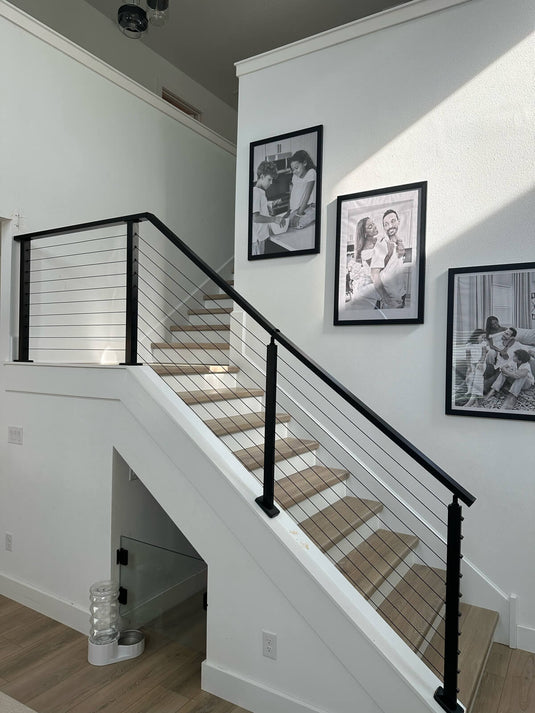TABLE OF CONTENTS
Must-Have Tools for a Flawless Deck Cable Railing Installation: Are You Prepared?
You've admired those gorgeous modern decks, the ones with slim, minimalist railings that provide a clean, unobstructed view. That's the appeal of a deck cable railing system. It appears clean, elegant, and deceptively straightforward. But when you go to install one yourself, you find very quickly that replicating that perfect, professional look boils down to one factor: having the right tools for the job. Without them, a dream project can fast devolve into a maddening mess of frayed cables and sagging lines. This guide will take you through every must-have tool to have you fully equipped.
Gather Your Foundational Tools
Before you even consider the specialized cutting and crimping equipment, you must get your basic project tools in line. These are the absolute essentials for just about any deck work and are the basis of your deck cable railing installation. Consider this your starting lineup.
Your measuring and marking tools come first and foremost. A good tape measure, a pencil, and a combination square are vital for making accurate layouts. You'll also want a good level—at least a 24-inch one—so that you can be sure your posts are plumb and your runs are straight. A sloppy layout at this stage will be magnified once the cables are installed.
Next is your power drill. If you're using blank posts (without pre-drilled holes), you may need to drill a dozen or more holes in each post — and with multiple posts in a project, that adds up to potentially hundreds of holes. A good, cordless power drill with a decent battery life is a necessity. Most DIYers also find an impact driver extremely handy for screwing in the posts and handrails that hold things together, since it provides more torque with less effort. Last but not least is your safety equipment. A good-quality pair of safety glasses and some durable work gloves aren't optional; they're necessities.
Select the Right Tools for Cutting and Drilling
This is where we move from general construction tools to the specific gear required for a deck cable railing project. Getting the cables and posts prepared correctly is a critical step, and these tools are designed to make that process smooth and precise.
Cable Cutters: Your Most Important Tool
Do not make the mistake of thinking your standard wire cutters or a pair of pliers will work here. They won't. Attempting to cut stainless steel cable with the wrong tool will crush and fray the end, making it impossible to slide into the fittings. You absolutely need a dedicated pair of cable cutters. These tools are designed with hardened steel jaws that shear the cable cleanly, leaving a perfect, un-frayed end. This is arguably the most important specialized tool you will buy for this job.
A Quality Drill Bit Set
You'll be drilling holes through your posts for the cable to pass through. The material of your posts—whether wood, composite, or metal—will determine the type of drill bit you need. Regardless, invest in a sharp, high-quality set. A dull bit will wander, tear the wood, or burn out when drilling through metal. For a clean deck cable railing installation, the holes need to be precise and clean.
A Drill Guide (Optional but Highly Recommended)
Drilling a perfectly straight hole by hand through a 4x4 or 6x6 post is incredibly difficult. A drill guide is a simple jig that attaches to your drill and ensures you drill at a perfect angle every time. This is especially crucial for intermediate posts where the cable must pass through cleanly. A slightly angled hole can cause the cable to bind and create unnecessary friction, making tensioning much harder. This small tool makes a huge difference in the final quality.
Master the Tensioning and Finishing Touches
Once your posts are set and your cables are run, the final step is to secure and tighten everything. This is what gives a deck cable railing its signature taught, clean look. The right tools here are not just for convenience; they are for structural integrity and safety.

The Cable Crimper or Swaging Tool
Many deck cable railing systems use "crimp-on" or "swage" fittings that attach to the ends of the cable. A crimping tool is what you use to securely fasten these fittings. There are two main types: mechanical hand crimpers, which look like oversized bolt cutters, and hydraulic crimpers, which use fluid pressure to apply greater force.
For small DIY projects, a hand crimper is affordable and effective. But if you're installing many cables or want an easier, more consistent result, a hydraulic crimper is the more convenient choice.
The Tensioning Wrench
After the fittings are attached, you need to tension the cables. Most threaded terminal fittings are tightened with a wrench. While some kits come with small, basic wrenches, having a set of your own good-quality open-ended wrenches will make the job much easier. This is how you will dial in that final, rigid tension that makes the railing safe and look great.
A Tension Gauge (The Pro's Secret)
How do you know when a cable is tight enough? You can go by feel, but professionals use a tension gauge. This small tool hooks onto the cable and gives you a reading of the exact tension level. This ensures every single cable run is tightened to the same spec, giving you a perfectly uniform look. More importantly, it helps you meet local building code requirements, which often specify a minimum tension to ensure the railing is safe.
Make the Job Easier with These Helpful Extras
While the tools listed above are the essentials, a few other items can save you time, improve the final look, and make the whole process less of a headache.
- Protective Sleeves and Grommets: For wood posts, installing protective sleeves in the drill holes prevents cable wear over time. Special protective sleeves and grommets are available for this, and they can greatly improve the durability of your railing.
- Extra Cable and Fittings: This isn’t a tool, but it's a critical tip. Always order about 10% more cable and a few extra fittings than you think you need. A single mis-cut or a bad crimp is inevitable, and having extras on hand will save you from a project-stopping trip to the store.
Put Safety First Throughout Your Project
On any project, safety must be your first concern. Wear your safety glasses at all times, particularly when cutting cable or working with a grinder, since tiny metal pieces can fly off. The cut ends of cable are extremely sharp, and gloves will save your hands from sore pokes and scratches. Lastly, read your local building codes for post spacing, handrail height, and cable tension specifications for your deck cable railing before starting.
Conclusion
A deck cable railing system is a great addition to any house, and with the proper preparation, it's a highly doable DIY project. Completion is not about owning the most high-end equipment; it's about owning the proper equipment for each particular task. Now that you know what you need, you're ready to create a stunning, modern railing that you'll be proud of for years to come.





